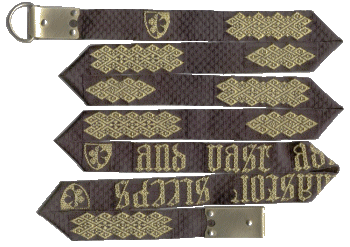
This belt was suppposed to be my entry in the 2003 Drachenwald Arts & Sciences Competition. Unfortunately the so-called courier took ten days to deliver the belt, by which time the event was already over...
A 13th Century Tabletwoven Brocaded Belt

This belt was suppposed to be my entry in the 2003 Drachenwald Arts & Sciences
Competition. Unfortunately the so-called courier took ten days to deliver the
belt, by which time the event was already over...
 Back to Articles Index.
Back to Articles Index.
I wove the belt using two separate but complementary techniques: brocading and twist patterning. Twist patterning is used to give a subtle texture and pattern to the fabric itself, while brocading is used to create patterns on the surface of the fabric by using contrasting weft threads.
Twist Patterning
The full descriptive name is twist-patterned warp twining, and as the name
implies the pattern is created solely by changing the twining direction (or twist)
of cords in the warp. Visually the pattern relies on a shadow effect created by
the change in twist, thus it is most effective with smooth, reflective material
such as silk.
One of the fascinations this style has for me is that the effect is very subtle. At a distance or on a quick glance the band appears plain, and only closer inspection reveals the pattern. Also, in contrast to most tabletweaving techniques, the pattern is tactile as well - the twist patterning affects the surface structure of the band and the changes can be felt by running a finger over the fabric.
The most basic example of this technique is the herringbone pattern created by turning alternately S- and Z-threaded tablets forwards continuously. A more interesting variation is the chequerboard pattern seen for example in the belt of King Philip of Swabia (1). This pattern is accomplished by threading the tablets in alternate groups of S and Z; the tablets are turned forwards for a certain number of turns, then backwards for the same number of turns. It is possible to form complex patterns and even letters with this technique (2).
Brocade
Brocading is the technique of using one or more additional wefts to create
patterns on a band. The brocade threads are not necessary for the structural
integrity of the fabric; they lie on the surface and are held down by being woven
into the material at certain points (the so-called tie-down points). The most
common brocade wefts were metallic threads which were made by wrapping finely
hammered gold or silver around a silk core (3).
Silk on its own was also used for
brocading - especially for coloured highlights - as was silver and gold wire.
Since metallic threads were difficult and labour intensive to produce and thus
very expensive material to use, the weavers tried to make as much of the brocade
weft visible as possible.
The vast majority of tabletwoven bands surviving from the middle ages were brocaded with gold or silver thread, not necessarily because brocading was so much more common than non-brocaded tabletweaving (an unlikely proposition, given the cost of the thread), but rather because the metal survived while the rest of the fabric disintegrated over time.
Brocaded tabletweaving has been consistently popular. Early Anglo-Saxon remnants can be dated to the 6th century (4), and examples from every century thereafter have been found, right into the high middle ages. Brocaded tabletweaving began to disappear only once tabletweaving itself lost ground in the 16th century to other styles of decoration such as lace (5).
Combined Twist Patterning and Brocade
The belt of King Philip of Swabia is a beautiful example of alternating areas of
twist-patterned squares and brocade. It is a bit difficult to tell from the photo
in Collingwood, but as far as I can make out by looking at the pattern of shadows
on the band it seems that the weaver did not carry through the twist-patterned
squares beneath the brocade. This makes sense for three reasons: firstly, if
the twist-patterned squares had been continued, at the points where the turning
direction had to be reversed the brocade weft would not have been as tightly
woven into the fabric; secondly, the twist-patterning would have been covered
by the brocade in any case; and thirdly, at the reversal points the hidden brocade
weft can show through.
The other question is whether the weaver changed the threading of the tablets at the point where the brocade begins to alternating S/Z threading by twisting the necessary tablets. This type of ground weave forms a slightly stronger and more even structure, and was used in the greater majority of period brocaded bands. However, looking at the photo of the band it seems to me that the weaver did not change the threading of the tablets but simply kept turning them in one direction, thus forming a background of broad warp-wise twist-patterned stripes beneath the brocade.
The brocaded areas are of three different types: my personal arms, a motto, and decorative knotwork.
Arms
There are a number of period examples of brocaded bands which incorporate arms
in their design. Several 13th/14th century bands have simple shield shapes and
basic heraldic fields (e.g. chequey, per pale etc) (6),
and a 13th century fragment which may have been part of a
belt (7)
shows 16 brocaded arms of some complexity,
but the most impressive example is the magnificent 13th century belt of Fernando
de la Cerda (8)
which incorporates detailed heraldry such as a lion rampant, three
lions passant guardant, a bendlet between six lions rampant
etc (9).
[2004-10-28: I misinterpreted the description. The heraldry is not brocaded,
but embroidered with beads. Bummer.]
My own arms, Per pale sable and Or a cinquefoil counterchanged are simple enough to be well suited for brocading, although it took me several attempts to design a decent cinquefoil. The five-point symmetry was not easy to achieve; I would have been much better off if the charge had been a quatrefoil or a trefoil.
Motto
The inscriptions on medieval bands were usually of a religious nature, and as
far as I can tell such bands were confined to use by the clergy. The 9th century
cingulum (10)
of Witgarius (11)
has a Latin inscription in Roman capitals along its
entire length; interestingly virtually the entire surface of the band is covered
by the gold thread and the letters are formed by the areas where the brocade
thread is hidden. Another example is a 15th century cingulum which combines
simple patterns with a long Latin inscription in Gothic minuscule (12).
Although I do not have evidence of mottos incorporated into tabletweaving, a motto can be seen in many ways as the secular equivalent of a religious inscription and as such makes a good substitute. I chose to use textura quadrata lettering (a form of Gothic minuscule) for my motto for a number of reasons. The script was in common use during the 13th to 15th centuries (13); it is a very regular script formed primarily of straight vertical and diagonal strokes, with only minimal difference to distinguish letters from each other and very few curving lines (14), which makes it ideal for brocading; and the 15th century cingulum gives evidence of its use in period tabletweaving.
This cingulum is especially interesting in the way the letters have been shaped. A calligraphed textura font has ascenders and descenders of 20% to 40% the height of the minims (15), but this means a lot of empty space above and below most of the letters if they are brocaded in the same fashion (and thus a lot of expensive metallic thread is hidden). The weaver of the cingulum took the approach of compressing letters with ascenders and descenders (16), thereby giving equal height to all letters and leaving no wasted space.
I designed several varieties of brocaded textura quadrata font before I decided to use one based on the style of the 15th century cingulum. I chose to use cross-like tie-downs because I like the patterned effect they give to the letters. This necessitated a slight tradeoff in the size of the letters - ideally the height of each letter should be about five times the width of a vertical stroke, but to accommodate the tie-downs in a neat fashion the letters had to be somewhat narrower than normal.
Knotwork
Brocaded knotwork motifs in a variety of styles are known from quite a number of
period bands. Several of the 9th century Birka bands have knotwork-like patterns
and interlaced lines (17),
and the 11th century chasuble of St Vitalis has bands with
a variety of knotwork patterns (18).
And again there's the belt of King Philip of Swabia,
which has evenly spaced brocaded knotwork motifs.
The three knotwork motifs I used are all based on the same underlying pattern. I originally designed the knotwork for a 3-colour doubleface warp, but I really liked the pattern and so for this belt I adapted it for brocading. I used a variety of cross shapes in the interstices of the knotwork to complement the cross-like tie-downs in the letters of the motto.
I created all patterns using GTT (Guntram's Tabletweaving Thingy). This is a Windows application I have been developing over the last two years to assist tabletweavers in creating and exchanging patterns. A sample screenshot of a brocade design in progress can be seen in Appendix E.
Of course this raises the question of whether it is proper to use such modern tools as a computer to assist with a medieval craft. I have considered this at fair length and decided that in this case I am justified, for three reasons:
Firstly, GTT does not provide any special 'wizard' features - none of the pattern design functions do anything that cannot be done by hand on a piece of paper. The main advantage in using a computer is that it is much easier to correct mistakes, and there is more scope for playing around with patterns, adjusting details and creating variations.
Secondly, the ideas and designs, and the skill in creating them still come from the user, not from the program. In the same way that I use a word processor to work out the text of a scroll before calligraphing it, I use GTT to design a pattern before weaving it.
And thirdly, since I wrote GTT myself all the help it provides is based directly on my own knowledge and experience.
Period tabletweavers generally used linen, wool, or silk, and most brocaded bands were woven with very fine silk (the threads were usually finer than our modern sewing threads). Nancy Spies advocates the use of 60/2 silk and Kreinik Japan #7 metallic thread as being a close approximation of period materials (19), and such is the yarn I chose. The Kreinik thread consists of a spun core wrapped with mylar, a synthetic material, and gives a good appearance of gold thread. Real gold metallic thread (a core wrapped with gold-plated silver foil) can sometimes be purchased from specialty suppliers, but is no doubt terribly expensive (20).
The choice of colours was very simple: since my arms are sable and Or, clearly the belt would have to be black silk brocaded with gold thread.
Weaving
I use a simple warp-weighted loom for tabletweaving. Warp-weighted looms (where
the yarn is being kept under tension by attached weights) were known in period,
though they were generally used for more traditional types of weaving rather
than tabletweaving.
Brocaded tabletweaving is quite simple in concept: for each tablet the weaver determines whether the brocade weft should go under or over the warp, passes through the weft, then passes the ground weft through the shed, and turns the tablets. This process is repeated for each line in the pattern. In practice it is not an excessively difficult technique either, but it is very slow indeed. Weaving the belt (excluding setting up the loom etc.) took me approximately 30 hours.
Finishing
There are various ways in which to finish off belts, but by far the most popular
period method seems to have been to protect both ends with metal casings of some
sort. Egan & Pritchard's Dress Accessories contains examples of a wide range of
buckles and strap-ends, some of which were still attached to the remnants of belts.
I chose to use one of the simplest styles shown by Egan & Pritchard: a strip of
metal of the same width as the belt, folded in the middle and riveted to the
fabric. This method serves to provide a decent strap-end as well as an attachment
point for a buckle.
| Warp | 60/2 silk, black |
| Weft | 60/2 silk, black |
| Brocade Weft | Kreinik Japan #7 metallic thread, gold |
| Width | varies between 25mm and 26.5mm |
| Length | 168cm, excluding buckle |
| Tablets |
64 four-hole tablets: 60 pattern tablets, in 7 groups of alternating S and Z threading. The outer two groups consist of 10 tablets, the inner five groups of 8 tablets each. |
| Patterns | Brocaded knotwork, arms, and motto; the brocaded areas are interspersed with squares of twist-patterned warp twining. |
| Picks/cm | ±15 picks/cm |
Appendix B: Period Belts and Bands
1. German silk band, Augsburg
9th or 10th century. Silk. Twist-patterned inscription.

Collingwood p157/plate 77.
2. Cingulum of Witgarius
9th Century. Silk. Brocaded inscription in Roman capitals.
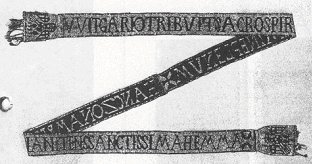
Suevia Sacra p192.
3. Chasuble of St Vitalis
11th Century. Silk. A variety of brocaded knotwork motifs, woven on separate
bands sewn to the chasuble.
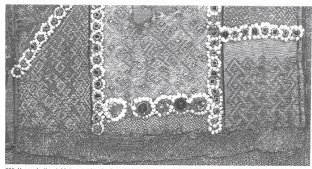
Flury-Lemberg p167.
4. Belt of King Philip of Swabia
12th or 13th Century. Silk. Squares of twist pattering are clearly visible
between the areas of brocaded knotwork.

Collingwood p155/Plate 75.
5. Belt of Fernando de la Cerda
13th Century. Silk. Two brocaded bands sewn back to back. Detailed heraldry.
The metal buckle and belt-end, decorated with more emblazons, are riveted to the
belt.
[2004-10-28: I misinterpreted the description. The heraldry is not brocaded,
but embroidered with beads. Bummer.]
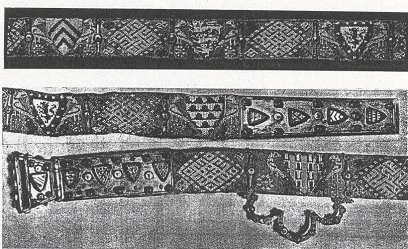
Gomez-Moreno Plate CXXXVI.
6. Band from Old Sarum, England
13th Century. Silk. The sketch shows details of the brocaded emblazons.
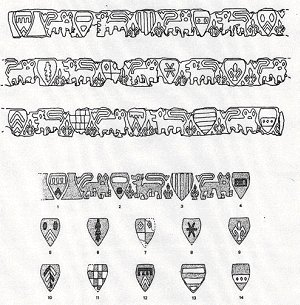
Crowfoot, Textiles.
7. Buckle
14th Century. Buckle of unspecified copper alloy riveted to a tabletwoven girdle.

Egan & Pritchard p49.
Arms
Per pale sable and Or, a cinquefoil counterchanged

Textura Quadrata
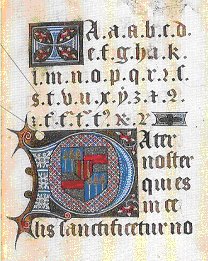 Textura Alphabet, 1386. Harris p51. |
  homo quidam, brocaded Textura Quadrata; 15th century Cingulum Spies p140. |

Appendix D: Period Metallic Thread
Electron microscope photograph of a 13th century metallic thread.
This screenshot shows one of my knotwork patterns in the design stage.

Collingwood, Peter. The Techniques of Tabletweaving. Faber and Faber, London 1982.
Crowfoot, Elisabeth. 'Textiles' in Salisbury Museum Medieval Catalogue. Salisbury and South Wiltshire Museum, 1991.
Crowfoot, Elisabeth; Pritchard, Frances; & Staniland, Kay. Textiles and Clothing 1150 - 1450. Boydell Press, Woodbridge 2001.
Drogin, Marc. Medieval Calligraphy: Its History and Technique. Dover Publications, New York 1989.
Egan, Geoff; & Pritchard, Frances. Dress Accessories 1150 - 1450. Boydell Press, Woodbridge 2002.
Geijer, Agnes. Birka III: Die Textilfunde aus den Gräbern. Uppsala 1938.
Gomez-Moreno, M. El Panteon Real de Las Huelgas de Burgos. Madrid 1946.
Harris, David. The Art of Calligraphy. Dorling Kindersley Limited, London 1985.
Kubach, Hans Erich; & Haas, Walter. Die Kunstdenkmäler von Rheinland-Pfalz: Der Dom zu Speyer. Deutscher Kunstverlag, 1972.
Priest-Dorman, Carolyn. Scutulis Dividere Gallia: Weaving on Tablets in Western Europe. 1988.
Spies, Nancy. Ecclesiastical Pomp & Aristocratic Circumstance: A Thousand Years of Brocaded Tabletwoven Bands. Arelate Studio, Jarrettsville 2000.
???. 'Zingulum des Bischofs Witgarius von Augsburg' in Suevia Sacra: Frühe Kunst in Schwaben. Augsburg 1973.
(1) Collingwood p155; Kubach & Haas p961.
(2) A 9th/10th century German silk band has an inscription of twist-patterned letters. Collingwood p157.
(3) See Appendix D.
(4) Collingwood p14; Spies p12.
(5) Priest-Dorman, "Scutulis Dividere Gallia" p7.
(6) Spies p129-130.
(7) Crowfoot, "Textiles".
(8) Gomez-Moreno p79.
(10) Cingulum = a clerical belt.
(11) Collingwood p332-333; Spies p25.
(12) Spies p140-141.
(13) Drogin p137.
(14) Drogin makes the interesting point that scribes intentionally shaped the letters similar to each other so that a written page would given the appearance of a woven pattern (textura in Latin).
(15) The minim is the basic letter height; n or o are generally used for this measurement.
(16) The ascenders and descenders are the strokes that rise above or drop below the area of the minims.
(17) Geijer p82-83.
(18) Spies p168-173.